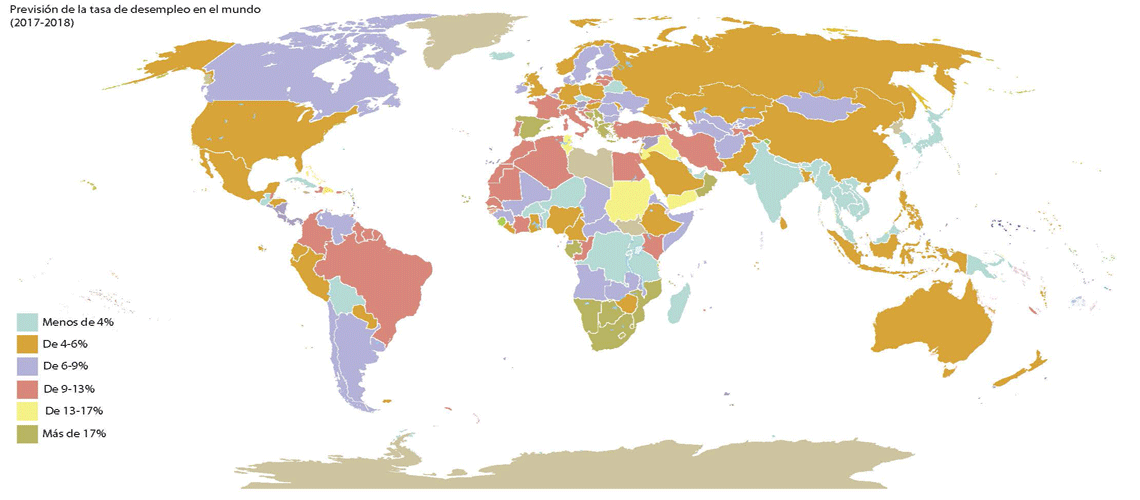The International Labour Organization has warned that the growth rate of the available work force shall exceed the rate of job creation and, therefore, 2,7 million more people will become unemployed in 2018. A further increase to the figures carried over from 2016 to 2017, a period in which the ILO has estimated that the global unemployment rate will rise from 5.7 to 5.8%. A 0.1 increase which translates into 3.4 million more unemployed people around the world. If these forecasts are correct, total unemployment will exceed 201 million people this year.
The increase in unemployment levels in 2017 is caused by the deterioration of labour market conditions in emerging countries. The effects of various deep recessions that took place in 2016 have affected and will continue to affect the current labour markets, according to the report titled ‘World Employment and Social Outlook – Trends 2017‘ (WESO) prepared by the ILO.
It explains that Latin America and Caribbean countries are faring badly, especially Brazil. Their unemployment rate has increased by 0.3 per cent in 2017, reaching 8.4%. Sub-Saharan Africa, on the other hand, has recorded their lowest employment growth rate in two decades. Both regions are also facing a strong increase in the number of working-age individuals. In emerging countries, the unemployment rate is also expected to rise from 5.6 to 5.7%, resulting in 3.6 million more unemployed people. Developing countries also present the same situation. Their unemployment levels are expected to be around 5.5% in 2017 and 2018, which implies 450,000 more unemployed people.
On the other hand, unemployment is expected to fall from 6.3 to 6.2% this year in developed countries, resulting in 670,000 fewer unemployed. More specifically, in Europe, especially in Northern, Southern and Western Europe, the number of people out of work will continue to decline, although the pace of this decline will slow down and the ILO sees signs that structural unemployment is getting worse. The same situation shall occur in the United States and Canada.
Increase in unstable employment
Regarding the quality of employment today, the ILO has warned of poor working conditions, the chronically poor quality employment, and the high rate of unstable employment, including self-employed workers and family members without income. In 2017, this could reach 42% of total employment, affecting 1,400 million people in the world.
“In emerging countries, nearly one out of every two workers have unstable jobs, and in developing countries, this situation affects more than four out of five workers”, said Steven Tobin, Chief ILO Economist and lead author of the report, which estimates the number of workers in unstable employment will increase each year by 11 million, and that South Asia and sub-Saharan Africa will be most seriously affected regions.
The report also mentions future challenges in eradicating poverty, as set out in the U.N. Sustainable Development Goals. The so-called working poor, those who live below the poverty line despite having jobs, are on the rise. More specifically, the number of workers earning less than $3.10 will increase by more than 5 million over the next two years in developing countries, stressed the ILO.
“In emerging countries, nearly one out of every two workers have unstable jobs, and in developing countries, this situation affects more than four out of five workers”
Another work-related problem is the amount of time people are unemployed. Europe and North America still have high levels of long-term unemployment in comparison to the levels seen before the crisis, according to the ILO. In the case of Europe, this indicator has increased, despite the decline in the unemployment rate. During the second quarter of 2016, 47.8% of the unemployed in the old continent had been looking for jobs for 12 months or more, and of these, more than two-thirds had been out of work for two years.
According to this report, “the global uncertainty and the lack of decent jobs, among other factors, is feeding social unrest and migration in many parts of the world”. Between 2009 and 2016, the proportion of the population in working age who wanted to migrate abroad increased in almost all regions of the world, except in South Asia, South-East Asia, and the Pacific region. The most significant increase took place in Latin America and the Caribbean and in the Arab States.
“We are facing a double challenge: we need to repair the damage caused by the global economic and social crisis and create quality jobs for the tens of millions of people each year who are joining the labour market”, said the ILO Director-General, Guy Ryder during the presentation of this report. “Economic growth is still disappointing and is lower than expected, regarding both its level and degree of inclusion. This draws a disturbing picture for the world economy and its ability to create enough jobs, let alone quality jobs. The persistence of a high number of unstable forms of employment, together with an apparent lack of improvement in job quality – even in countries where the aggregate figures are improving – is alarming. We must ensure that the gains from growth are shared in an inclusive manner”, concluded Ryder.














